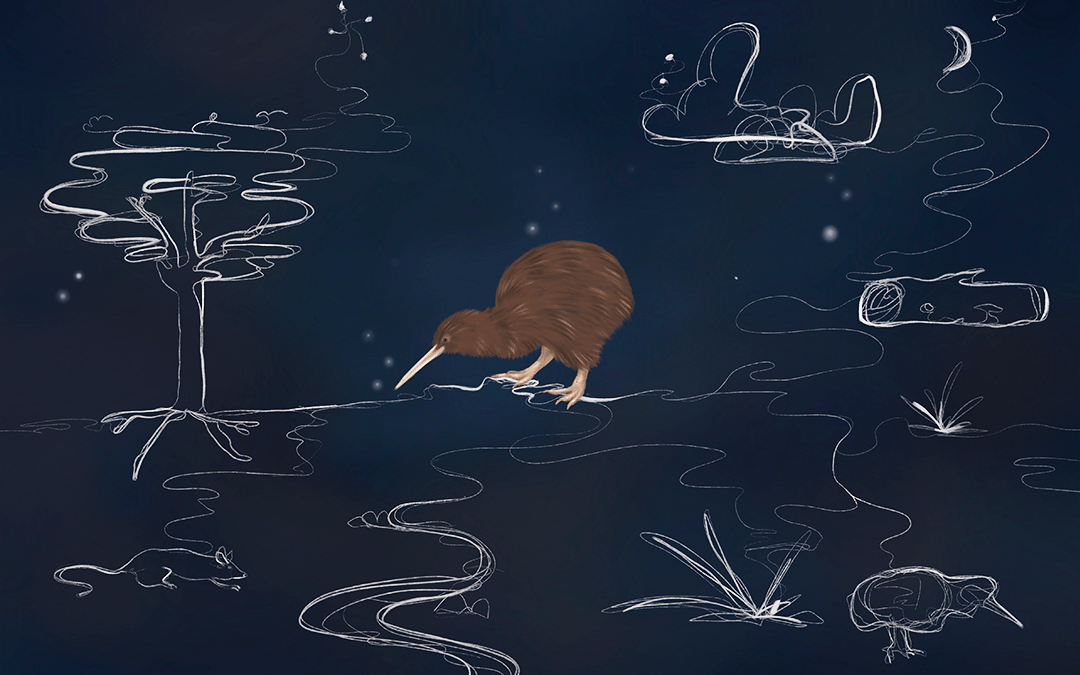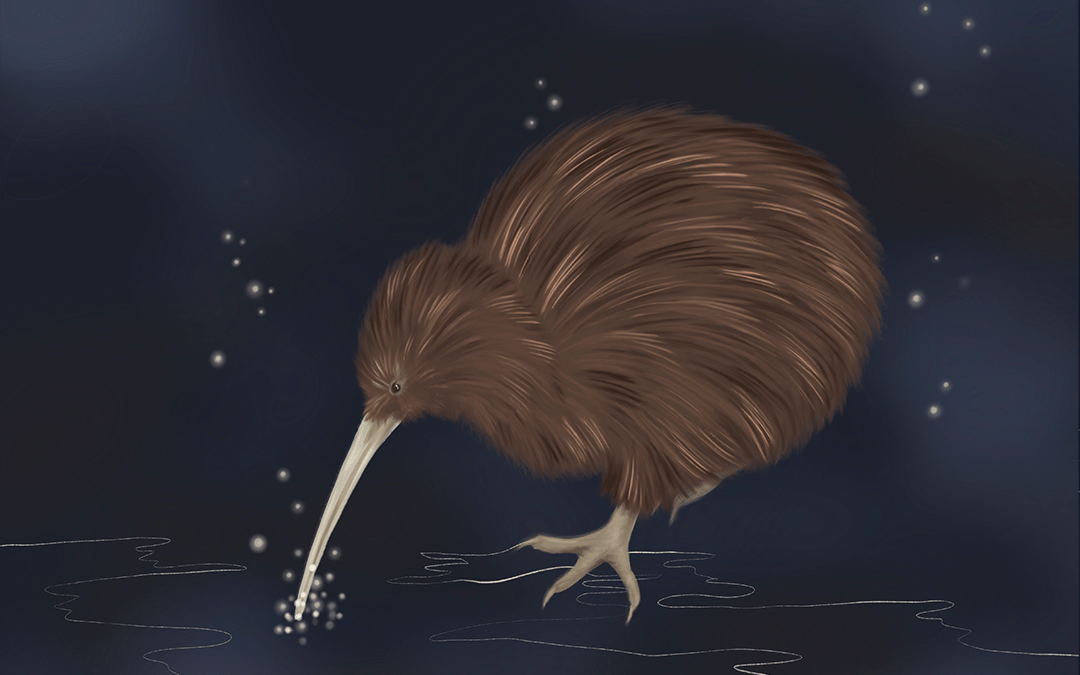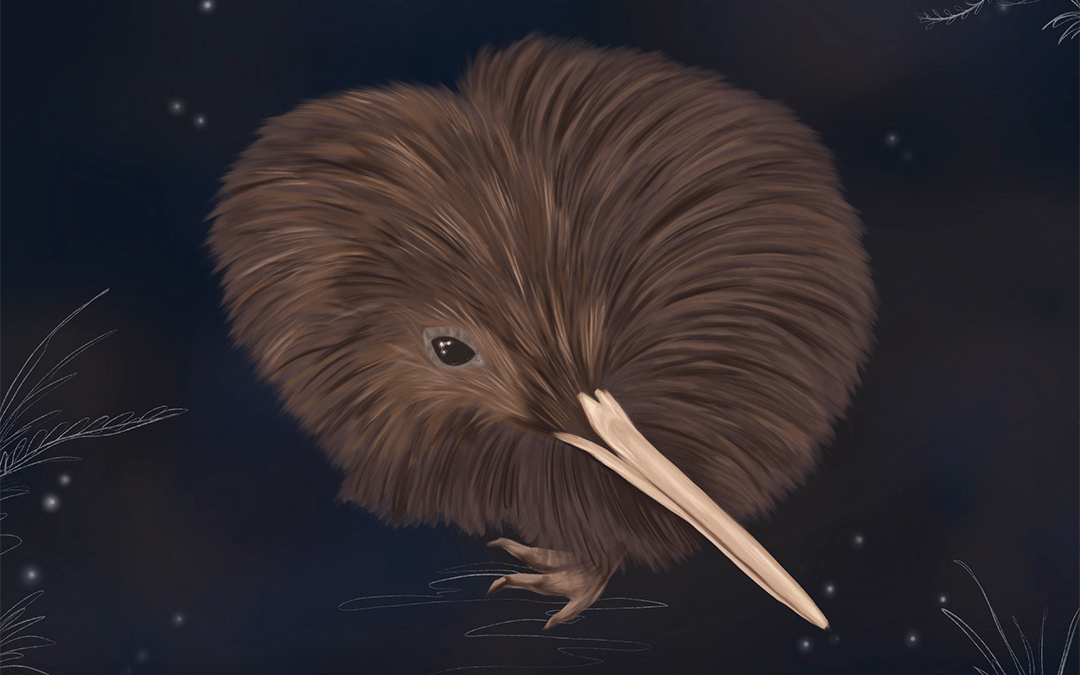4 December 2023
A collaboration between wildlife biologist Isabel Castro and illustrator Jean Donaldson. Edited by Jonathan Burgess.
Kiwi are a group of five extant species of birds endemic to Aotearoa New Zealand. Their bodies are rounded, and they have a long bill that curves down at the end of a long neck. They belong to an ancient group of birds at the base of the avian tree of life. They have tiny wings that are useless for all intents and purposes, but a very large brain for a bird. Their brain is large due to the enlargement of several of the areas needed for cognition (innovative feeding, social behaviour, and vocal learning) and integration of information.
Kiwi are nocturnal. They are active during the dark hours and rest in burrows or hideaways during the daytime. Being nocturnal poses many challenges. They have very small eyes, but a highly-developed sense of smell — something that can be used in the dark to get information about their surroundings, especially other animals.
I always encourage my students working with kiwi to try to become a kiwi by sitting in the darkness of a moonless night on the forest floor. I ask them to close their eyes and take some time to adjust to the darkness, inside and out. We must close our eyes as our sense of sight is so strong that having them open would interfere with other sensations.
The sense of touch becomes important when one cannot see. Feeling the air and the cold around bare patches of skin — especially the face and hands — can help with navigation, social interactions, and gathering weather information. By listening to the sounds around us we can identify animals moving in the understory, mosquitoes approaching, and the song of the nocturnal species like ruru allows us to know about other kiwi, predators, and parasites.
I ask them to smell the air, and ask what is in it. What plants can they recognise? Animals? What can they say about their environment as they use their senses like kiwi? When they get up, can they walk safely? What would they need to walk?
After a few tries, a person can distinguish between the noises made by rats, mice, donkeys, sheep, kiwi, other birds roosting in the trees, insects, and other humans when walking in the bush. They can also detect the presence of streams by their sounds and tell the height of the canopy by listening to the wind on the tops of trees. Smelling is not as easy, but we can easily smell the flowering plants in an area, wet soil, and many smells brought in by the wind — many we cannot identify. We can walk aided by a stick or by placing our arms outstretched. The easiest is going on all fours!
Although not confirmed, I imagine that kiwi use their large brain to form mental maps of what is in their environment. I think it could be like having a map or GPS that allows them to move safely around as long as things stay in the same place. In case something drops on to the forest floor, or moves, they use their tap-ahead behaviour, where they touch the ground in front with their bill as they move, to make sure they do not trip on things. In addition to using air movement around their body, sounds and smells, this would allow kiwi to have a pretty good picture of what their area is like.

By touching obstacles with their bill, kiwi can also update their mental maps by adding new obstacles. When a tree or a new plant falls on the forest floor, many kiwi in an area come to it and for the first few days of falling they have a heightened interest in it. I think this allows them to add it to their map.
When we were studying the foraging behaviour of kiwi my PhD student Susan Cunningham and I would find a kiwi in the darkness of the night while walking around with a low light head torch and would stop to video him or her using infrared technology.
We recognised the kiwi because of two main bits of information they provide while out at night. Firstly, they looked like a dark basketball (their body) with a bright white stick (their bill) in front of the ball. The reason why the bill is so prominent in the dark is unknown, but it could be possible that it reflects light in a special way that makes it more visible. That way kiwi could find each other by looking at the whiteness of each other’s bills.

The other giveaway is their extremely noisy movements — especially in the middle of a dry spell when the understory is crunchy underfoot. Kiwi are so noisy one could think it is a human walking around!
Once we stopped, we would start to video their behaviour. Invariably, the bird would be at least ten metres away from us, but as time went by they would get closer and closer while seemingly indifferently smelling in our direction. We took it that they were interested in us and our presence and approached to check us at a range that would allow a better understanding of what we were. If we moved and made a sound or coughed or cleared our throats, they would run a short distance away and start the process again.
While kiwi can call and they have different sounding calls for males and females (and possibly individuals), they only call on average about once per night. We found that pairs and groups that nest together tend to be within earshot of each other’s movements and I wonder whether these close-range sounds are used to know the position of the members of their social group.
I imagine that this would be like recognising the walking pattern of a familiar person. It would be super interesting to record such sounds and see whether individuals have specific identifiable patterns.
Isabel Castro is a principal investigator with Te Pūnaha Matatini who researches how an animal’s biology and behaviour affect its conservation status.
Jean Donaldson is a designer and illustrator who works with Toi Āria: Design for Public Good. She is based in Te Whanganui-a-Tara. You can see more of her work at https://jeanmanudesign.com/.
Special thanks to Professor Stephen Marsland, who co-leads the Ponui Island Kiwi Research Programme, David Chamberlin and family who own our study site and are members of our team, and the many postgraduate students who help us discover amazing facts about kiwi.

